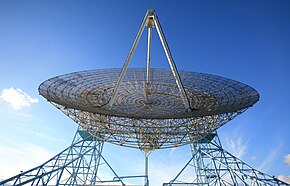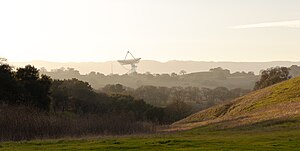Stanford Dish
 | |
| Alternative names | The Dish |
|---|---|
| Location(s) | California, Pacific States Region |
| Coordinates | 37°24′30″N 122°10′44″W / 37.4083°N 122.179°W |
| Organization | SRI International |
| Telescope style | radio telescope |
| Diameter | 150 ft (46 m) |
| Website | dish |
| | |

The Dish is a radio telescope in the Stanford foothills. The 150-foot-diameter (46 m) dish was built in 1961 by the Stanford Research Institute (now SRI International). The cost to construct the telescope was $4.5 million, and was funded by the United States Air Force, with the original purpose of studying the chemical composition of the atmosphere.[1]
Later on, the Dish was used to communicate with satellites and spacecraft. With its unique bistatic range radio communications, where the transmitter and receiver are separate units, the powerful radar antenna was well-suited for communicating with spacecraft in regions where conventional radio signals may be disrupted.[citation needed]
At one point, the Dish transmitted signals to each of the Voyager craft that NASA dispatched into the outer reaches of the solar system.[2] It has also been used to remotely recalibrate ailing satellites orbiting the Earth.[citation needed]
Today
The dish is still actively used today for academic and research purposes.[3] It is owned by the U.S. Government and operated by SRI International. It is used for commanding and calibrating spacecraft, and for radio astronomy measurements.[4]
Recreational route
The area around the Dish offers a popular 3.5 mile recreational trail, visited by an average of 1,500–1,800 people daily.[5] The trail around the dish is known for its rolling hills and beautiful views, which on a clear day extend to San Jose, San Francisco, and the East Bay. While hikers, walkers, and runners are welcome, biking and dogs at the dish are not allowed. The opening hours are as per the schedule below, roughly matching daylight hours:
| Jan | Feb | Mar | Apr | May | Jun | Jul | Aug | Sep | Oct | Nov | Dec | |
|---|---|---|---|---|---|---|---|---|---|---|---|---|
| opens (AM) | 6:30 | 6:30 | 6:00 | 6:00 | 6:00 | 6:00 | 6:00 | 6:00 | 6:30 | 6:30 | 6:30 | 6:30 |
| closes (PM) | 5:00 | 5:30 | 6:30 | 7:30 | 7:30 | 7:30 | 7:30 | 7:30 | 7:00 | 6:00 | 5:00 | 5:00 |
In 2011, 213 cows lived on the grounds of the Stanford Dish, according to Stanford's real estate office.[citation needed] Stanford leases the land to farmers who own the cows.
Mountain lion sightings

A sign at the entrance to the Stanford Dish encourages recreational users to keep an eye out for mountain lions. The area is a known habitat for the large cats, though sightings are extremely rare.[citation needed]
Most recently, Stanford University issued a warning in January 2011 after mountain lion tracks were spotted outside the entrance to the Dish at the intersection of Junipero Serra Boulevard and Campus Drive West. Fresh tracks were seen on dirt trails leading to Lake Lagunita, on the campus side of Junipero Serra.[6]
References
- ^ "Radar Dish Erected on SU Campus". The Stanford Daily. October 2, 1961.
- ^ "Voyager: The Grand Tour of Big Science". NASA. Retrieved 20 June 2015.
- ^ "Welcome to the Stanford Dish". Stanford University. Retrieved 26 May 2014.
- ^ "The "Dish" Radio Antenna Facility". SRI International. Retrieved 20 August 2014.
- ^ STANFORD UNIVERSITY / Mountain lion attack jolts horse country / Dish Trail users still jog and hike - but are wary
- ^ http://news.stanford.edu/news/2011/january/mountain-lion-precaution-011811.html

